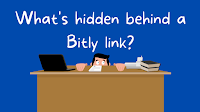
30 Dec Best of 2021 – See What’s Behind Bitly and TinyURL Without Clicking
Bitly is a handy URL shortener that I’ve used for many years. As a registered user I can create custom, shortened URLs that people can actually spell. I use these whenever I need to share a link to a Canva or Google Slides presentation because the default URLs provided by those services are always long and incoherent.
Unfortunately, not all Bitly users are using them for good reasons. Some people use them to hide nefarious links. Fortunately, there is an easy way to quickly determine what’s behind a Bitly URL without actually clicking on the link. The trick is to simply add a “+” to the end of any Bitly URL. When you add the “+” the URL will redirect to Bitly instead of to whatever the original URL was. That will then show you the Bitly page on which the shortened URL is hosted and will show you what the original link was.
You can try this trick with a URL that I recently shortened. Bit.ly/THWTAPRIL will lead you directly to a copy of the slides that I used in my recent Intro to Teaching History With Technology webinar. Bit.ly/THWTAPRIL+ will lead you to the Bitly page where you can see my original presentation URL and see when I created the shortened URL.
Watch this short video to see how you can use the “+” trick to find out what’s hidden behind a Bitly link.
If you want to try this with a TinyURL, tinyurl.com/emkns9a8 will lead you to the page for the Practical Ed Tech Virtual Summer Camp, but adding a “+” at the end of that TinyURL will take you to the page where you can see the original link without clicking on it.
Here’s a video overview of how to see what’s behind a TinyURL without actually clicking on the link.
Applications for Education
Building good digital citizenship and cyber safety skills is something that all of us should be helping our students do. Showing them little tips like this one to avoid clicking on suspicious links is one of the ways that we can help our students build their digital citizenship and cyber safety skills.
As I do every year, I’m taking this week as a break from publishing new blog posts and will be republishing some of the most popular posts of the year. Here’s one from April.Bitly is a handy URL shortener that I’ve used for many years. As a registered user I can create custom, shortened URLs that people can actually spell. I use these whenever I need to share a link to a Canva or Google Slides presentation because the default URLs provided by those services are always long and incoherent. Unfortunately, not all Bitly users are using them for good reasons. Some people use them to hide nefarious links. Fortunately, there is an easy way to quickly determine what’s behind a Bitly URL without actually clicking on the link. The trick is to simply add a “+” to the end of any Bitly URL. When you add the “+” the URL will redirect to Bitly instead of to whatever the original URL was. That will then show you the Bitly page on which the shortened URL is hosted and will show you what the original link was. You can try this trick with a URL that I recently shortened. Bit.ly/THWTAPRIL will lead you directly to a copy of the slides that I used in my recent Intro to Teaching History With Technology webinar. Bit.ly/THWTAPRIL+ will lead you to the Bitly page where you can see my original presentation URL and see when I created the shortened URL. Watch this short video to see how you can use the “+” trick to find out what’s hidden behind a Bitly link. If you want to try this with a TinyURL, tinyurl.com/emkns9a8 will lead you to the page for the Practical Ed Tech Virtual Summer Camp, but adding a “+” at the end of that TinyURL will take you to the page where you can see the original link without clicking on it. Here’s a video overview of how to see what’s behind a TinyURL without actually clicking on the link. Applications for Education Building good digital citizenship and cyber safety skills is something that all of us should be helping our students do. Showing them little tips like this one to avoid clicking on suspicious links is one of the ways that we can help our students build their digital citizenship and cyber safety skills. This post originally appeared on FreeTech4Teachers.com. If you see it elsewhere, it has been used without permission. Best of 2021, bitly, Free Technology For Teachers, how to, tinyurlRead More
Best of 2021, bitly, Free Technology For Teachers, how to, tinyurlRead More


Sorry, the comment form is closed at this time.